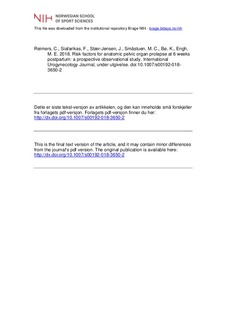| dc.contributor.author | Reimers, Cathrine | |
| dc.contributor.author | Siafarikas, Franziska | |
| dc.contributor.author | Stær-Jensen, Jette | |
| dc.contributor.author | Småstuen, Milada Cvancarova | |
| dc.contributor.author | Bø, Kari | |
| dc.contributor.author | Engh, Marie Ellström | |
| dc.date.accessioned | 2019-04-04T12:51:49Z | |
| dc.date.available | 2019-04-04T12:51:49Z | |
| dc.date.created | 2018-04-17T14:35:45Z | |
| dc.date.issued | 2018 | |
| dc.identifier.citation | International Urogynecology Journal. 2018, 30, 477-482 | nb_NO |
| dc.identifier.issn | 0937-3462 | |
| dc.identifier.uri | http://hdl.handle.net/11250/2593354 | |
| dc.description | I Brage finner du siste tekst-versjon av artikkelen, og den kan inneholde ubetydelige forskjeller fra forlagets pdf-versjon. Forlagets pdf-versjon finner du på link.springer.com / In Brage you'll find the final text version of the article, and it may contain insignificant differences from the journal's pdf version. The definitive version is available at link.springer.com | nb_NO |
| dc.description.abstract | Introduction and hypothesis: The objective was to identify risk factors for postpartum anatomic pelvic organ prolapse (aPOP) by comparing women with and without aPOP at 6 weeks postpartum with regard to pelvic floor measurements antepartum and obstetrical characteristics. Methods: We carried out a prospective observational cohort study including nulliparous pregnant women in a Norwegian university hospital. Participants underwent clinical examinations, including pelvic organ prolapse quantification system (POP-Q) and transperineal ultrasound at gestational week 21 and at 6 weeks postpartum. Background and obstetrical information was obtained from an electronic questionnaire and from the patient’s electronic medical file respectively. Associations were estimated using logistic regression analyses. The dependent variable was aPOP, defined as POP-Q stage ≥2 at 6 weeks postpartum. Independent variables were mid-pregnancy measurements of selected POP-Q variables and levator hiatus area (LHarea), delivery route, and the presence of major levator ani muscle (LAM) injuries at 6 weeks postpartum. Results: A larger LHarea, a more distensible LAM, a longer distance from the meatus urethra to the anus (Gh + Pb) and a more caudal position of the anterior vaginal wall (Ba) at mid-pregnancy were risk factors for aPOP at 6 weeks postpartum, whereas delivery route and the presence of major LAM injuries were not. Conclusion: Prelabor differences in the pelvic floor rather than obstetrical events were risk factors for aPOP at 6 weeks postpartum. | nb_NO |
| dc.language.iso | eng | nb_NO |
| dc.subject | pelvic organ prolapse | nb_NO |
| dc.subject | pelvic floor | nb_NO |
| dc.subject | pop | nb_NO |
| dc.subject | postpartum | nb_NO |
| dc.subject | pregnancy | nb_NO |
| dc.title | Risk factors for anatomic pelvic organ prolapse at 6 weeks postpartum: a prospective observational study | nb_NO |
| dc.title.alternative | Risk factors for anatomic pelvic organ prolapse at 6 weeks postpartum: a prospective observational study | nb_NO |
| dc.type | Journal article | nb_NO |
| dc.type | Peer reviewed | nb_NO |
| dc.description.version | acceptedVersion | nb_NO |
| dc.source.pagenumber | 6 | nb_NO |
| dc.source.journal | International Urogynecology Journal | nb_NO |
| dc.identifier.doi | 10.1007/s00192-018-3650-2 | |
| dc.identifier.cristin | 1579864 | |
| dc.description.localcode | Seksjon for idrettsmedisinske fag / Department of Sports Medicine | nb_NO |
| cristin.unitcode | 150,34,0,0 | |
| cristin.unitname | Seksjon for idrettsmedisinske fag | |
| cristin.ispublished | true | |
| cristin.fulltext | postprint | |
| cristin.qualitycode | 1 | |
